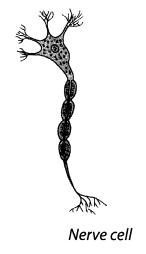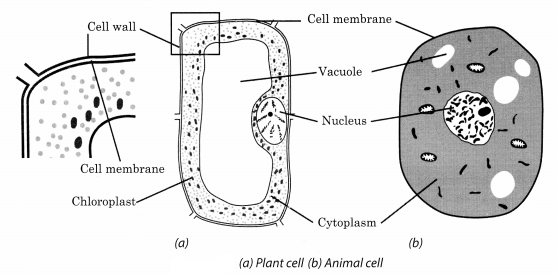EVENTS CONVENT HIGH SCHOOL
16/11/2021 CLASS - 8 SESSION 2021-22
SUBJECT : SCIENCE
CHAPTER-8 CELL STRUCTURE AND FUNCTIONS
______________________________________
Question 1.Indicate whether the following statements are True (T) or False (F).
(a) Unicellular organisms have a one-celled body.
(b) Muscle cells are branched.
(c) The basic living unit of an organism is an organ.
(d) Amoeba has an irregular shape.
Answer:
(a) True
(b) True
(c) False
(d) True
Question 2.Make a sketch of the human nerve cell. What function do nerve cells perform?
Answer:
Function of nerve cells: The function of the nerve cell is to receive and transfer messages, it helps to control and coordinate the working of different parts of the body.
Question 3.Write short notes on the following.
(a) Cytoplasm
(b) Nucleus of a cell
Answer:
(a) Cytoplasm: The jelly-like substance found between the nucleus and the cell membrane is called cytoplasm. It is made up of basic elements like C, H, O, N. Various other components or organelles, like mitochondria, Golgi bodies, ribosomes, etc., of cells are present in the cytoplasm.
(b) Nucleus of a cell: Nucleus of a cell is an important component of the living cell. It is located at the centre of the cell. It is separated from the cytoplasm by a membrane called nuclear membrane. It contains genetic material.
Question 4.Which part of the cell contains organelles?
Answer:
Cytoplasm
Question 5.Make sketches of animal and plant cells. State three differences between them.
Answer:
| Plant cells | Animal cells |
| (i) The outermost covering is a cell wall and it is made of cellulose. | (i) The outermost covering of animal cell is the plasma membrane. |
| (ii) Plastids are present in plant cells. | (ii) Plastids are absent in animal cells. |
| (iii) Large vacuoles are present in plant cells. | (iii) No or very small vacuoles are present in animal cells. |
| (iv) It lacks centrosomes and lysosomes. | (iv) They have centrosomes or lysosomes. |
Question 6.State the difference between eukaryotes and prokaryotes.
Solution:
| Eukaryotes | Prokaryotes |
| (i) Eukaryotes possess membrane-bound organelles. | (i) Prokaryotes lack membrane-bound organelles. |
| (ii) Nucleus of the cell has nuclear membrane. Example: higher plants and animals. | (ii) Nucleus is not bounded by membrane. Example: bacteria and blue-green algae. |
Question 7. Where are chromosomes found in a cell? State their function.
Answer:
Chromosomes are present in the nucleus. The functions of chromosomes is to carry genes on them and to transfer the character from parents to the next generation.
Question 8. ‘Cells are the basic structural units of living organisms.’ Explain.
Answer:
Different cells combine to form tissues and tissues combine to form organs. Similarly, organs combine to form body. Thus they are termed as the basic structural unit of every living organism.
Question 9. Explain why chloroplast are found only in plant cells?
Answer:
Chloroplasts are plastids required for the food making process, called photosynthesis, and thus they are only present in plant cells.

